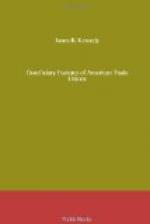[Footnote 197: Cigar Makers’ Journal, Vol. 6, July, 1881, p. 1.]
[Footnote 198: Ibid., Vol. 9, July, 1884, p. 3.]
CHAPTER V.
SUPERANNUATION BENEFITS.
In 1901 thirty-eight of the one hundred principal British unions paid a superannuation benefit. These unions had a membership of 566,765, and the amount paid in superannuation benefits from 1892 to 1901 was about one sixth of the total amount expended for all benefits.[199] In the American trade unions, on the other hand, superannuation benefits are paid by only a few unions. A considerable number of unions have in recent years been considering the advisability of introducing this feature, and it is likely within a brief period to form an important part of the beneficiary system of the American unions.
[Footnote 199: Weyl, “Benefit Features of British Trade Unions,” in Bulletin of the Bureau of Labor, Vol. 12, p. 722.]
The superannuation benefit may take several forms—a weekly stipend, a lump sum or a support in a home for the aged. The aim of the benefit in all three cases is to protect the member in old age. The weekly stipend is regarded as the preferable form, since in going to a home the member must leave his family. Ordinarily, too, a weekly payment is deemed wiser than a lump sum, since the aged member cannot very well manage property, and the chances are that he will lose his capital. The British trade unions uniformly pay the benefit in the form of a weekly or monthly pension.
The earliest attempt made by any American trade union to make provision for the support of aged members was that of the Typographical Union in 1857. The National Convention of that year appointed a committee to consider the proposal of the Philadelphia printers for the establishment of an “Asylum for Superannuated and Indigent Printers.” This plan was defeated at the ninth convention in 1860.[200] The Iron Molders’ Union as early as 1874 provided for the establishment of a “superannuated fund,” from which superannuated members of twenty years’ standing were to receive three hundred dollars and those of twenty-five years’ four hundred, if permanently disabled and unable to earn a living at their trade. Membership was to date from July 5, 1859, and no benefit was to be paid until August, 1879.[201] Because of the failure to accumulate sufficient reserve for its support, the regulations were repealed in 1878 before any benefit fell due.[202] The superannuation benefit adopted by the Granite Cutters early in their history met a similar fate.
[Footnote 200: Proceedings of the Seventh Convention, Chicago, 1858 (New York, 1858), p. 11; Proceedings of the Ninth Convention, Nashville, 1860 (Boston, 1860), pp. 53-54.]
[Footnote 201: Constitution, 1876 (Cincinnati, 1876), Art. 18.]
[Footnote 202: Constitution, 1878 (Cincinnati, 1878), Art. 17; Iron Molders’ Journal, August, 1878, p. 4; October, 1878, p. 30.]




